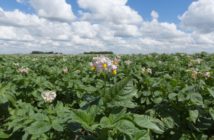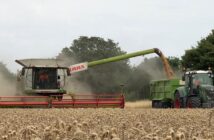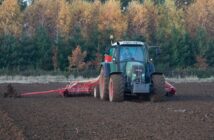Limagrain UK have launched Stem Health which offers measurable and tangible levels of stem-based disease resistance, helping oilseed rape varieties maintain healthy stems for longer and enabling the crop to reach it full yield potential.
Stem Health covers the three main stem-based diseases – OSR-phoma, Cylindrosporium (Light leaf spot) and verticillium.
Arable technical officer for Limagrain, Liam Wilkinson, said that the Stem Health mark will confirm a variety’s tolerance to stem-based diseases in a quantifiable way: “For a Limagrain variety to hold the Stem Health tag it has to offer high levels of disease resistance to all three diseases – one single weakness leads to exclusion from the Stem Health list, or the right to carry the Stem Health claim.”
The aim is for this characteristic to bring a level of genetic security to help mitigate risk. Mr Wilkinson continued: “Stem health is generally an area that is often overlooked but can have a serious impact on gross output. However by having healthy green stems longer into the growing season we often see higher yields and oil content. As breeders, we have recognised that the best way to mitigate the risk to on-farm performance from these diseases, is through improved genetics, therefore Stem Health has been a key focus for the Limagrain European breeding programme.”
Limagrain’s access to its three European breeding stations as well as its collaboration with national institutes and universities means that the company has been able to test and evaluate material, resulting in improvements of LG germplasm. Varieties LG Auckland and the newly-recommended Attica are the first in the LG breeding programme to offer Stem Health. This is reflected in their consistently high gross output of 107 and 106% respectively.
Confidence in oilseed rape
William Charlton, Limagrain’s arable marketing manager, said that this year’s continued confidence in the crop comes following high commodity prices and growers gaining a better understanding of establishing the crop under CSFB and weather challenges.
He said: “Oilseed rape is still the best non-cereal break crop, and second to first wheats in many situations in terms of farm gross margins – and with newer varieties bringing improved yields, vigour and agronomic characteristics to the rotation – growers are seeing the opportunity provided by the crop.
“We saw a big rebound in the crop in 2021, with the planted area for harvest 2022 up around 361,000 ha’s. This year, we expect that to go up to 414,000 ha’s sown. We also see the popularity of hybrids increasing, with hybrids making up 71% of the crop drilled this year, and only 19% of the crop is down to conventional varieties and 10% to farm saved seed. There is no doubt that the rise in popularity of hybrids is led by their vigour, as well as their ability, in the case of Limagrain hybrids, to offer Stem Health, TuYV, Clubroot, Pod Shatter and RLM7 resistance – all of which contribute to yield stability, which we know is what growers are looking for on-farm,”




